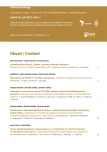Steel syndrome – the first case of rare skeletal dysplasia in Slovakia: a case report
Authors:
Oravcová Lucia 1; Skalická Katarína 1; Pribilincová Zuzana 1; Tichá Ubica 1; Hamidová Olívia 1; Ilčík Milan 2; Podracká Udmila 1
Authors‘ workplace:
Detská klinika LF UK a NÚDCH, Bratislava
1; Rádiologické oddelenie LF UK a NÚDCH, Bratislava
2
Published in:
Clinical Osteology 2021; 26(1): 29-34
Category:
Overview
Steel syndrome is an ultra-rare autosomal recessive disease affecting primarily the skeletal system. It is characterized by short stature, bilateral hip and radial head dislocations, carpal coalitions, scoliosis and pes cavus. Other features of the disease are facial dysmorphism, long oval face, prominent forehead, hypertelorism, macrocephaly, low-lying ears, brachydactyly or hearing loss. Steel syndrome is caused by mutations in the Col27A1 gene encoding the pro-alpha chain of fibrillar collagen type XXVII. We report an extremely rare case of an 8-year-old girl with mild skeletal dysplasia, constitutively delayed growth, hypertelorism and facial dysmorphism. In the patient, we identified the presence of two unknown heterozygous variants in the Col27A1 gene by whole exome sequencing: c.1741C>T, p.(Gln581Lys) and c.2858C>T, p. (Pro953Leu). At our department, we diagnosed the second case of Steel syndrome in Europe and at the same time it is the first case of this rare disease in the Slavic population.
Keywords:
Col27A1 gene – skeletal dysplasia – Steel syndrome – whole exome sequencing
Sources
- Steel HH, Piston RW, Clancy M et al. 1993. A syndrome of dislocated hips and radial heads, carpal coalition, and short stature in Puerto Rican children. J Bone Joint Surg Am 1993; 75(2): 259–264. Dostupné z DOI: <https://doi.org/10.2106/00004623–199302000–00013>.
- Pölsler L, Schatz UA, Simma B et al. A Syrian patient with Steel syndrome due to compound heterozygous COL27A1 mutations with colobomata of the eye. Am J Med Genet A 2020; 182(4): 730–734. Dostupné z DOI: <https://doi.org/10.1002/ajmg.a.61478>.
- Boot-Handford RP, Tuckwell DS, Plumb DA et al. A novel and highly conserved collagen (pro(alpha)1(XXVII)) with a unique expression pattern and unusual molecular characteristics establishes a new clade within the vertebrate fibrillar collagen family. J Biol Chem. 2003; 278(33): 31067–31077. Dostupné z DOI: <http://dx.doi.org/10.1074/jbc.M212889200>.
- Gonzaga-Jauregui C, Gamble CN, Yuan B et al. Mutations in COL27A1 cause Steel syndrome and suggest a founder mutation effect in the Puerto Rican population. Eur J Hum Genet 2015; 23(3): 342–346. Dostupné z DOI: <https://doi.org/10.1038/ejhg.2014.107>.
- Gariballa N, Ben-Mahmoud A, Komara M et al. 2017. A novel aberrant splice site mutation in COL27A1 is responsible forSteel syndrome and extension of the phenotype to include hearing loss. Am J Med Genet 2017; 173(5): 1257–1263. Dostupné z DOI: <https://doi.org/10.1002/ajmg.a.38153>.
- Maddirevula S, Alzahrani F, Al-Owain M et al. Autozygome and high throughput confirmation of diseasegenes candidacy. Genet Med 2019; 21(3): 736–742. Dostupné z DOI: <http://dx.doi.org/10.1038/s41436–018–0138-x>.
- Kotabagi S, Shah H, Shukla A et al. Second family provides further evidence for causation of Steel syndrome by biallelic mutations in COL27A1. Clin Genet 2017; 92, 323–326. Dostupné z DOI: <https://doi.org/10.1111/cge.13006>.
- Thuresson A, Soussi Zander C, Zhao JJ et al. Whole genome sequencing of consanguineous families reveals novel pathogenic variants in intellectual disability. Clin Genet 2019; 95(3): 436–439. Dostupné z DOI: <https://doi.org/10.1111/cge.13470>,
- Gonzaga-Jauregui C, Yesil G, Nistala H et al. Functional biology of the Steel syndrome founder allele and evidence for clan genomics derivation of COL27A1 pathogenic alleles worldwide. Eur J Hum Genet 2020; 28(9): 1243–1264. <http://dx.doi.org/10.1038/s41431–020–0632-x>.
- Kritioti E., Theodosiou A., Nicolaou N et al. First reported case of Steel syndrome in the European population: A novel homozygous mutation in COL27A1 and review of the literature. Eur J Med Genet 2020; 63(7):103939. Dostupné z DOI: <http://dx.doi.org/10.1016/j.ejmg.2020.103939>.
- Flynn JM, Ramirez N, Betz R et al. Steel syndrome: dislocated hips and radial heads, carpal coalition, scoliosis, short stature, and characteristic facial features. J Pediatr Orthop 2010; 30(3): 282–288. <http://dx.doi.org/10.1097/BPO.0b013e3181d3e464>.
- Belbin GM, Odgis J, Sorokin EP et al. Genetic identification of a common collagen disease in Puerto Ricans via identity-bydescent mapping in a health system. Elife 2017; 6: e25060. Dostupné z DOI: <https://doi.org/10.7554/eLife.25060>.
- Amlie‐Wolf L, Moyer‐Harasink S, Carr A et al. Three new patients with Steel syndrome and a Puerto Rican specific COL27A1 mutation. Am J Med Genet A 2020; 182(4): 798–803. Dostupné z DOI: <https://doi.org/10.1002/ajmg.a.61465>.
- Lawrence C, Fryer JG, Karlberg P et al. Modelling of reference values for size at birth. Acta Paediatr Scand Suppl 1989; 350: 55–69. Dostupné z DOI: <http://dx.doi.org/10.1111/j.1651–2227.1989.tb11198.x>.
- Plumb DA, Ferrara L, Torbica T et al. Collagen XXVII organises the pericellular matrix in the growth plate. PLoS One 2011; 6(12): e29422. Dostupné z DOI: <http://dx.doi.org/10.1371/journal.pone.0029422>.
Labels
Clinical biochemistry Paediatric gynaecology Paediatric radiology Paediatric rheumatology Endocrinology Gynaecology and obstetrics Internal medicine Orthopaedics General practitioner for adults Radiodiagnostics Rehabilitation Rheumatology Traumatology OsteologyArticle was published in
Clinical Osteology

2021 Issue 1
- Metamizole vs. Tramadol in Postoperative Analgesia
- Memantine in Dementia Therapy – Current Findings and Possible Future Applications
- What Effect Can Be Expected from Limosilactobacillus reuteri in Mucositis and Peri-Implantitis?
- Metamizole at a Glance and in Practice – Effective Non-Opioid Analgesic for All Ages
Most read in this issue
- Relapsing hypercalcemia – a hard diagnostic nut to crack: a case report
- Pseudohypoparathyroidism type Ib: a case report and review of literature
- Steel syndrome – the first case of rare skeletal dysplasia in Slovakia: a case report
- Osteoporosis associated with pregnancy: a case report
